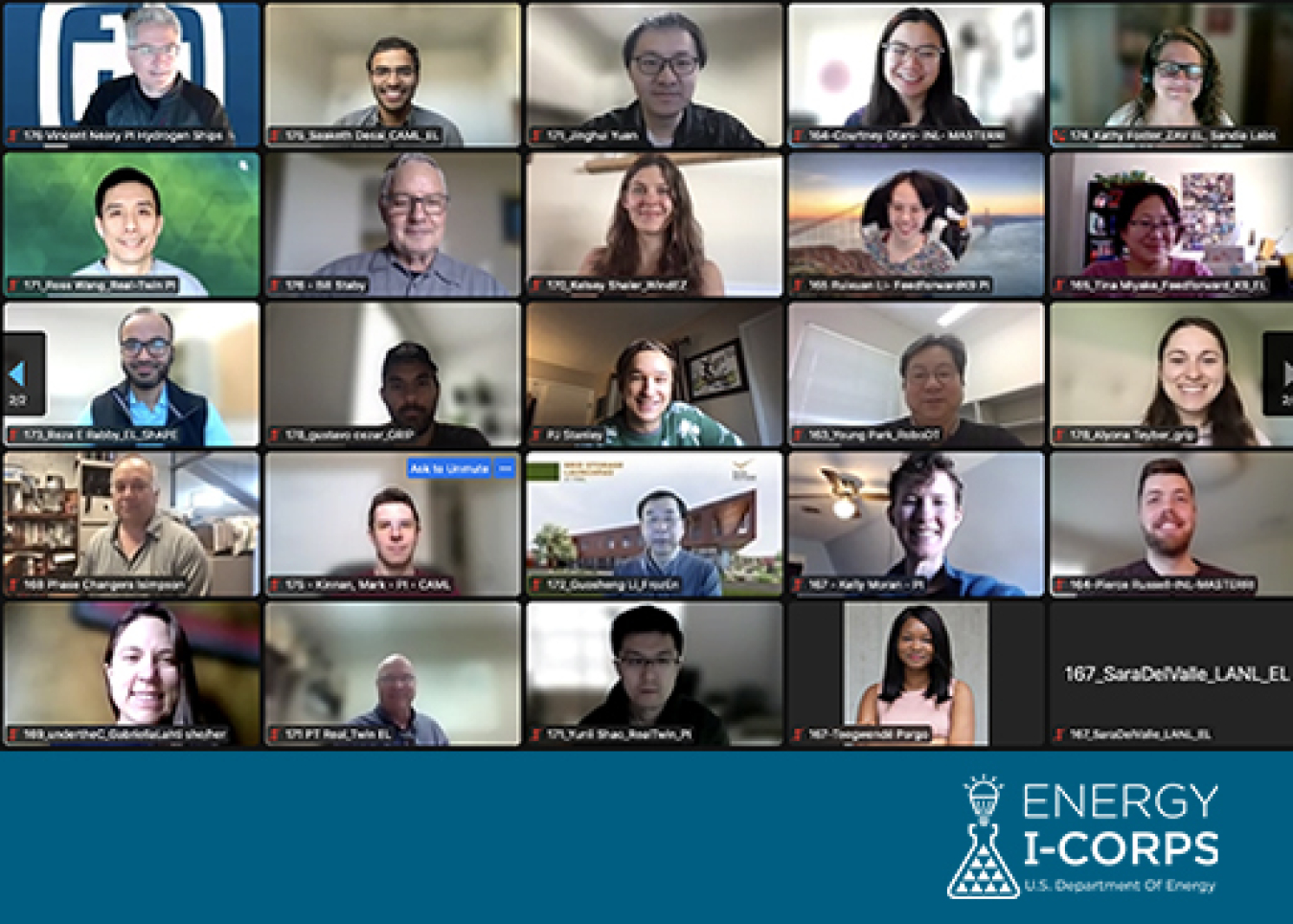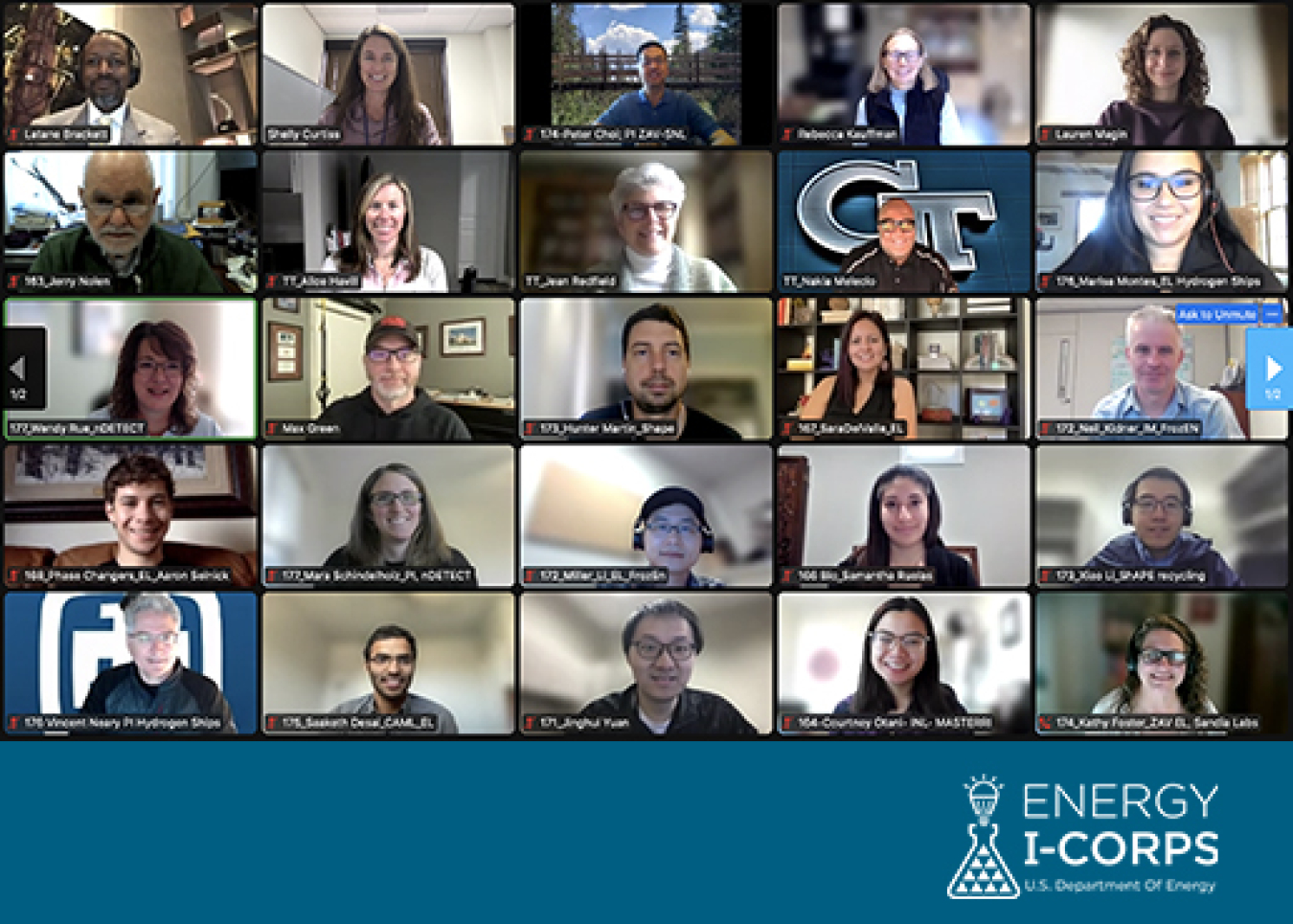Energy I-Corps is a key initiative of our office that ensures the U.S. Department of Energy's (DOE) investment in the national labs maintains and strengthens long-term U.S. competitiveness.
Office of Technology Transitions
May 4, 2022
Energy I-Corps is a key initiative of our office that ensures the U.S. Department of Energy's (DOE) investment in the national labs maintains and strengthens long-term U.S. competitiveness. The two-month program brings together teams of researchers with industry mentors to provide meaningful real-world opportunities for the application of commercialization and entrepreneurial skills to DOE technologies.
Researchers learn to define technology value propositions, conduct stakeholder discovery interviews, and develop viable market pathways for their technologies. They return to the lab with a framework for industry engagement to guide future research and inform a culture of market awareness within the labs.

Since its founding, 165 teams from 12 national laboratories have participated in the Energy I-Corps program representing a wide range of energy innovations, including waterpower technologies, hydrogen and fuel cell technologies, bioenergy, and more. More than 160 industry mentors have participated, and the teams have facilitated more than 11,500 customer discovery interviews with companies such as Lowes, Johns Manville, LEGO, the U.S. Army, Tesla, GM, and many more.
Cohort 14, which began at the end of March and will graduate in mid-May, is comprised of 16 teams representing nine national labs and nine DOE program offices. The Cohort benefits from the highest number of female participants since the program began and teams are working in a broad field of clean energy technologies. They are:
- RoboDT from Argonne National Laboratory: This project focuses on robotic digital twin (RDT) technology, which allows network-distributed integration of robotic technologies—control remote sensing, real-time modeling, mixed-reality, and AI—on a digital twin platform.
- MASTERRI from Idaho National Laboratory: The MASTERRI (Modeling and Simulation for Targeted Electrical Reliability and Resilience Improvement) technology allows for quantifiable failure analysis of complex systems/networks such as electrical grids.

- Feedforward K9 from Idaho National Laboratory: The feedforward visualization technique leverages the capabilities of AI technologies, including machine learning (ML) and control logic (i.e., procedures), to provide decision support and alert operators to limit nuclear incidents.
- Bioreactor from Lawrence Livermore National Laboratory: This project aims to develop high-performance solid-state bioreactors for biogas-to-liquid chemicals production by methanotrophs.
- Disease Precognition from Los Alamos National Laboratory: The Global Disease Forecasting Center (GDFC) offers a robust platform to assess trends and accurately identify potential disease outbreaks within communities, employing proprietary models and machine learning approaches to analyze data streams and create actionable information.
- Phase Changers from National Renewable Energy Laboratory: This team is supporting novel technologies that can provide large utility scale energy storage required for a future where renewables is the dominant form of energy generation and simultaneously capture greenhouse gases.
- µnder the C from National Renewable Energy Laboratory: The technology is an in-situ river microplastic sensor platform that is networked, low-cost, self-powered, user-deployable, and capable of producing scientific-quality data.
- WindEZ from National Renewable Energy Laboratory: WindEZ will make adoption and continued use of NREL's open-sourced wind-focused software a smoother experience for the general user including GUI development and comprehensive tutorials.
- Real-Twin from Oak Ridge National Laboratory: The core of Real-Twin is a realistic and streamlined scenario generation capability that ingests real-world data and establishes a TWIN representation of the transportation system.

- FrozEn from Pacific Northwest National Laboratory: The FrozEn battery team’s so called “freeze-thaw” battery technology helps long-duration, seasonal electricity storage in a rechargeable battery without the conventional self-discharge and degradation.
- ShAPE Recycling from Pacific Northwest National Laboratory: Shear assisted processing and extrusion (ShAPE) is an advanced manufacturing technology that converts bulk billet or finely divided precursors into valuable products with high efficiency.
- ZAV-SNL from Sandia National Laboratory: Zero trust Application for Vehicle (ZAV) eliminates the need for Key Management Services (KMS) by dynamically generating cryptographic keys as needed, thereby reducing KMS-related risks and available attack surfaces for cyber hackers.
- CAML from Sandia National Laboratory: This team aims to use computational modeling and machine learning strategies to identify new reaction pathways for chemical-based recycling solutions.
- Hydrogen Ships from Sandia National Laboratory: A sailing renewable hydrogen energy ship transfers wind sail power to hydrokinetic power captured by relatively small water turbines attached to the ship’s hull. The electric energy generated by this hydrokinetic turbine is used to manufacture and store pressurized or liquefied hydrogen.
- nDETECT from Sandia National Laboratory: The technology is a long-lived, direct-electrical readout sensor for gas detection. The sensor is composed of an interdigitated electrode with a nanoporous adsorbent layer.
- GRIP from SLAC National Accelerator Laboratory: GRIP (Grid Resilience and Intelligence Platform) is designed to address extreme weather resilience using data and technology-agnostic methodology to present analytics that can be easily deployed on any electrical utility platform to help them make informed operational decisions before, during, and after an event.
Every Energy I-Corps cohort has a teaching team that empowers participants with the tools, resources, and relationships necessary to discover potential market pathways for their energy innovations. Instructors for Cohort 14 bring critical industry expertise to the program and introduce the language of innovation and commercialization to the participating teams. We are proud to host the following industry experts, each with their own deep technical backgrounds and advanced business experience:

- Latane Brackett, Principal Manager, Innovation Programs, GEM i4
- Max Green, Founder and Managing Member, Ratio Flux
- Alice Havill, Independent Consultant
- Rebecca Kauffman, Principal, Sun Raven
- Nakia Melecio, Senior Research Faculty, Georgia Institute of Technology
- Jean Redfield, CFO and Co-Founder, Fordsell Machine Products
With each iteration of Energy I-Corps, the national lab community has increased its capacity to ensure that research can have measurable impact on our innovators, in our economy, and ultimately, for the public good. Throughout its seven years of existence, 13 teams have launched new businesses based on the technology they developed with the program, and all teams continue to raise post-program funding, with more than $110 million raised by this year. Stay tuned for what successes Cohort 14 will enjoy!


